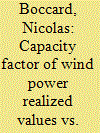| Srl | Item |
| 1 |
ID:
088266


|
|
|
|
|
| Publication |
2009.
|
| Summary/Abstract |
For two decades now, the capacity factor of wind power measuring the average energy delivered has been assumed in the 30-35% range of the name plate capacity. Yet, the mean realized value for Europe over the last five years is below 21%; accordingly private cost is two-third higher and the reduction of carbon emissions is 40% less than previously expected. We document this discrepancy and offer rationalizations that emphasize the long term variations of wind speeds, the behavior of the wind power industry, political interference and the mode of finance. We conclude with the consequences of the capacity factor miscalculation and some policy recommendations
|
|
|
|
|
|
|
|
|
|
|
|
|
|
|
|
| 2 |
ID:
128003


|
|
|
|
|
| Publication |
2014.
|
| Summary/Abstract |
The Fukushima disaster has lead the French government to release novel cost information relative to its nuclear electricity program allowing us to compute a levelized cost. We identify a modest escalation of capital cost and a larger than expected operational cost. Under the best scenario, the cost of French nuclear power over the last four decades is View the MathML source (at 2010 prices) while in the worst case it is View the MathML source. On the basis of these findings, we estimate the future cost of nuclear power in France to be at least View the MathML source and possibly View the MathML source. A comparison with the US confirms that French nuclear electricity nevertheless remains cheaper. Comparisons with coal, natural gas and wind power are carried out to find the advantage of these.
|
|
|
|
|
|
|
|
|
|
|
|
|
|
|
|
| 3 |
ID:
096626


|
|
|
|
|
| Publication |
2010.
|
| Summary/Abstract |
We investigate the concomitance of intermittent wind powered generation (WPG) with load to assess its system value as the cost of replacing its output, hour by hour, using more intensively thermal technologies. The difference with its actual cost defines a social cost of wind power which is further divided into a technological and an adequacy component. Whereas the former may become negligible once thermal technologies pay for carbon emissions, the latter is a lower bound on WPG structural weakness w.r.t. thermal technologies.
We apply our procedure to Germany, Denmark, Spain, France, Portugal and Ireland using hourly load and WPG data over several years. Our empirical findings show that there is a grain of truth in both the pros and the cons of wind power. The system value of WPG varies from three quarters of the equivalent thermal cost of electricity (on a yearly basis) but the incompressible adequacy cost represents a premium over the cost of serving yearly load in a system ranging around one-fifth.
|
|
|
|
|
|
|
|
|
|
|
|
|
|
|
|
| 4 |
ID:
097465


|
|
|
|
|
| Publication |
2010.
|
| Summary/Abstract |
We investigate the concomitance of intermittent wind powered generation (WPG) with load to assess its system value as the cost of replacing its output, hour by hour, using more intensively thermal technologies. The difference with its actual cost defines a social cost of wind power which is further divided into a technological and an adequacy component. Whereas the former may become negligible once thermal technologies pay for carbon emissions, the latter is a lower bound on WPG structural weakness w.r.t. thermal technologies.
We apply our procedure to Germany, Denmark, Spain, France, Portugal and Ireland using hourly load and WPG data over several years. Our empirical findings show that there is a grain of truth in both the pros and the cons of wind power. The system value of WPG varies from three quarters of the equivalent thermal cost of electricity (on a yearly basis) but the incompressible adequacy cost represents a premium over the cost of serving yearly load in a system ranging around one-fifth.
|
|
|
|
|
|
|
|
|
|
|
|
|
|
|
|